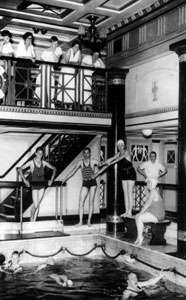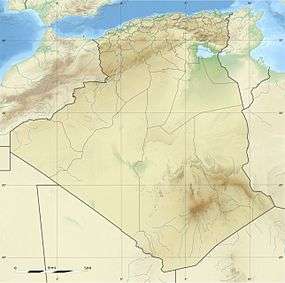RMS Viceroy of India
 As HMS Viceroy of India on the Clyde in World War II | |
| History | |
|---|---|
| Name: | RMS Viceroy of India |
| Namesake: | Viceroy & Governor-General of India |
| Owner: |
|
| Operator: |
|
| Port of registry: |
|
| Route: | Tilbury — Bombay[2] |
| Builder: | Alexander Stephen and Sons, Glasgow[1] |
| Cost: | £1,090,987 |
| Yard number: | 519[3] |
| Laid down: | April 1927 |
| Launched: | 15 September 1928[3] |
| Christened: | By Dorothy, Countess of Halifax, wife of the 1st Earl of Halifax, Viceroy of India |
| Completed: | March 1929[1] |
| Maiden voyage: | 7 March 1929 |
| In service: | 7 March 1929 |
| Out of service: | 11 November 1942 |
| Homeport: | Tilbury |
| Identification: |
|
| Fate: | sunk 11 November 1942 by U-407[5] |
| General characteristics | |
| Class and type: | ocean liner |
| Tonnage: | |
| Length: | |
| Beam: | 76.2 ft (23.2 m)[1] |
| Draught: | 28 ft 2.75 in (8.60 m)[1] |
| Depth: | 41.5 ft (12.6 m)[1] |
| Decks: | 5 |
| Installed power: | |
| Propulsion: | |
| Speed: | 19 knots (35 km/h)[6] or 20 knots (37 km/h)[2] |
| Capacity: |
|
| Crew: |
|
| Sensors and processing systems: | direction finding equipment[1] |
RMS Viceroy of India was an ocean liner of the Peninsular and Oriental Steam Navigation Company (P&O). She was a British Royal Mail Ship on the Tilbury–Bombay route[2] and was named after the Viceroy of India. In World War II she was converted to and used as a troopship. She was sunk in the Mediterranean in November 1942 by German submarine U-407.
Building

P&O ordered the ship from Alexander Stephen and Sons of Glasgow in 1927. She was originally to be called Taj Mahal,[3] after the 17th-century mausoleum of Mumtaz Mahal in New Delhi. She was laid down in April 1927, launched in September 1928 and completed in March 1929. She cost £1,090,987[7]
She had six water-tube boilers with a combined heating surface of 32,500 square feet (3,019 m2) that supplied steam at 400 lbf/in2 to two turbo generators.[1] These supplied current to electric motors with a combined rating of 3,565 NHP that drove twin screw propellers.[1] British Thomson-Houston (BT-H) of Rugby, Warwickshire built the turbo-generators and motors.[1]
Each turbo-generator ran at 2,690–3,110 RPM, producing three-phase current at 2,720 volts and rated at 900 kW. Each propeller shaft was driven by two three-phase 3,150 volt electric motors running at 109 RPM and giving 8,500 shp (6,300 kW) per shaft. At reduced power of up to 11,600 shp (8,700 kW) only one turbo-generator was needed to supply current to both motors, thus maximising fuel economy. Variation of propeller speed in either direction was achieved by changing the turbine speed.
The accommodation aboard was considered luxurious by the standards of the era. The first class staterooms were especially so, but standards were high in all classes on this ship. All cabins were single berth with interconnecting doors, with extra rooms for servants who often travelled with colonial families. Her onboard amenities also included the then unusual luxury of an indoor swimming pool. Much of the interior decoration was designed by the Honourable Elsie Mackay, youngest daughter of James Mackay, 1st Earl of Inchcape,[7] who was the chairman of P&O from 1914 until his death in 1932.
Viceroy of India carried cargo as well as passengers, and her holds were refrigerated for carrying perishables.[1]
Launch and commissioning
The ship was launched as Viceroy of India on 15 September 1928 by Dorothy, Countess of Halifax, the wife of the Viceroy of India, E. F. L. Wood, 1st Earl of Halifax. The name had been changed to avoid offending Indians, particularly Muslims, for whom the Taj Mahal mausoleum is sacred.
Fitting out at Shieldhall Wharf, Glasgow, began on 8 January 1929. Viceroy of India was finished in P&O's traditional colours: her hull black with a white band, her boot topping red, her upper works and lifeboats buff, her large vents black, her small vents buff and her two funnels black.[8][9]
During fitting out she was damaged amidships by Donaldson South American Line's 7,131 GRT cargo ship Corinaldo, which was trying to dock in poor visibility. However, by 17 February Viceroy of India was ready for sea trials, on which she averaged 19.6 knots (36.3 km/h).[7] She was completed in March 1929.[1]
P&O turbo-electric ships
Viceroy of India was Britain's first large turbo-electric passenger ship.[10] At about the same time as she was built, P&O also had RMS Mooltan's performance increased by the addition of BT-H turbo generators and propulsion motors to supplement her quadruple-expansion engines.
P&Os first experiences of turbo-electric propulsion led the company to specify the same form of transmission for a pair of liners[11] that it ordered in 1930: RMS Strathnaver (completed in 1931) and RMS Strathaird (completed in 1932). Each "Strath" was only about 2,600 GRT bigger than Viceroy of India but they produced about 77% more power, which made them about 3 knots (5.6 km/h) faster than Viceroy of India.
Civilian service

Viceroy of India was handed over to P&O on 7 March 1929 and made her maiden voyage on the Indian mail route. Viceroy of India was also suited for leisure cruises, which she made every year until the outbreak of World War II in September 1939.[7]
On 9 August 1929, she collided with the tug Olanda at Venice, Italy; Olanda was beached after the collision.[12]
On 23 November 1929 Viceroy of India rescued 25 crew members from the Italian cargo steamer Maria Luisa which sank in the eastern Mediterranean[7] off the coast of Egypt.
In February 1930 Viceroy of India was bethed in Bombay when the 6,070 GRT British India Line ship Warfield collided with her. The collision pushed the liner against a dockside crane, which she demolished. Viceroy of India herself escaped serious damage.[7]
Later in 1930 Viceroy of India twice assisted the Greek cargo steamer Theodoros Bulgaris in the Bay of Biscay. In September she stood by when Theodoros Bulgaris' cargo of grain shifted in storms and the Greek merchantman's crew were transferred to another vessel. On 31 December 1930 Theodoros Bulgararis sank and Viceroy of India rescued all of the crew.[7]
In September 1932, Viceroy of India set a new record time between London and Bombay of 17 days, 1 hour, 42 minutes.[7]
On 5 September 1935 the Cunard White Star liner Doric and the Chargeurs Réunis cargo ship Formigny collided off Cape Finisterre. Doric stayed afloat but her 736 passengers were transferred to other ships as a precaution; 241 of them were transferred to Viceroy of India.[7]
In February 1939, Viceroy of India cruised to the South Atlantic, where she became the first P&O liner to visit the island of Tristan da Cunha.[7]
On 11 August 1940 the Shaw, Savill & Albion liner Ceramic and Bank Line cargo liner Testbank collided in the South Atlantic off Walvis Bay. Both ships stayed afloat but Ceramic′s 279 passengers were transferred to Viceroy of India as a precaution.[7]
War service and sinking

On 12 November 1940 the Ministry of War Transport requisitioned Viceroy of India to be a troop ship.[5] She returned to the River Clyde for the conversion.[7]
In 1942 Viceroy of India sailed in Convoy KMF-1A carrying Allied troops from Britain to invade French North Africa in Operation Torch.[5] Early on 11 November 1942 she was returning empty from Algiers bound for Gibraltar.[5] At 0524 hrs she was about 34 miles (55 km) northwest of Oran when German submarine U-407 fired a spread of four torpedoes at her.[5] Two hit the ship, killing four crew members.[5] At 0531 hrs U-407 fired a stern-tube torpedo at her but missed.[5] The B-class destroyer HMS Boadicea took Viceroy of India in tow but she sank and Boadicea rescued all 432 surviving crew and 22 passengers.[5]
Notes

- 1 2 3 4 5 6 7 8 9 10 11 12 13 14 15 16 17 18 19 20 21 Lloyd's Register of Shipping (PDF). London: Lloyd's Register. 1930. Retrieved 1 May 2013.
- 1 2 3 Talbot-Booth 1942, p. 368
- 1 2 3 4 5 Cameron, Stuart; Strathdee, Paul; Biddulph, Bruce (2002–2013). "SS Viceroy of India". Clydebuilt database. Clydesite.co.uk. Retrieved 1 May 2013.
- ↑ Lloyd's Register, Steamers & Motorships (PDF). London: Lloyd's Register. 1934. Retrieved 20 May 2013.
- 1 2 3 4 5 6 7 8 Helgason, Guðmundur (1995–2013). "Viceroy of India". uboat.net: Ships hit by U-boats. Guðmundur Helgason. Retrieved 1 May 2013.
- ↑ Harnack 1938, p. 560.
- 1 2 3 4 5 6 7 8 9 10 11 12 "Viceroy of India (1929)" (PDF). Fact Sheet. P&O Heritage. June 2009. Retrieved 5 August 2014.
- ↑ Talbot-Booth 1942, pp. 534–535.
- ↑ Harnack 1938, p. 559.
- ↑ Harnack 1938, pp. 83–84.
- ↑ Harnack 1938, p. 303.
- ↑ "Casualty reports". The Times (45279). London. 12 August 1929. col G, p. 20.
References
- Harnack, Edwin P (1938) [1903]. All About Ships & Shipping (7th ed.). London: Faber and Faber.
- Talbot-Booth, E.C. (1942) [1936]. Ships and the Sea (Seventh ed.). London: Sampson Low, Marston & Co. Ltd.
Coordinates: 36°26′N 0°24′W / 36.433°N 0.400°W